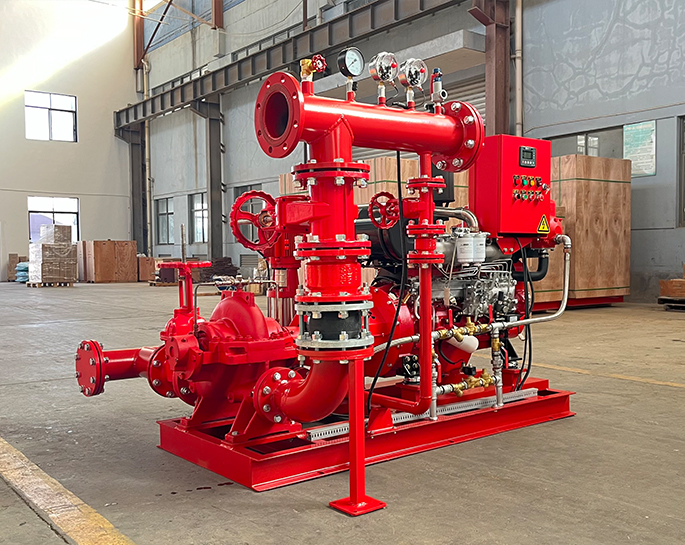What are the considerations for selecting the appropriate fire pump performance testing procedures for electric fire pump systems?
Apr 08, 2024
Share:
Selecting the appropriate fire pump performance testing procedures for electric fire pump systems involves several considerations to ensure the system operates effectively during emergencies. Here are some key considerations:
1. **Regulatory Requirements**: Ensure compliance with local, national, and international regulations and standards such as NFPA 20 (Standard for the Installation of Stationary Pumps for Fire Protection) and NFPA 25 (Standard for the Inspection, Testing, and Maintenance of Water-Based Fire Protection Systems). These standards outline specific testing procedures and frequencies.
2. **Manufacturer Recommendations**: Follow the manufacturer's guidelines and recommendations for testing procedures. They often provide detailed instructions for conducting tests specific to their equipment, including testing frequencies, procedures, and performance criteria.
3. **System Design**: Consider the design specifications of the fire pump system, including its capacity, pressure ratings, and intended application. Testing procedures should align with the system's design parameters to ensure accurate performance evaluation.
4. **System Complexity**: Evaluate the complexity of the fire pump system, including any integrated controls, backup power sources, and ancillary components. Testing procedures should account for the entire system's functionality and interdependencies.
5. **Risk Assessment**: Conduct a risk assessment to identify potential hazards and failure points within the fire pump system. Tailor testing procedures to address critical components and failure scenarios that pose the highest risk to life safety and property protection.
6. **Testing Methodologies**: Determine the appropriate testing methodologies based on the specific requirements of the fire pump system. This may include flow tests, pressure tests, suction tests, net positive suction head (NPSH) tests, and full-load performance tests, among others.
7. **Testing Frequency**: Establish a testing schedule based on regulatory requirements, manufacturer recommendations, and risk assessments. Routine testing should be conducted to verify the system's performance and identify any issues promptly.
8. **Qualified Personnel**: Ensure that testing procedures are conducted by qualified personnel with the necessary training, experience, and certifications. This may include licensed fire protection engineers, certified technicians, or qualified contractors familiar with fire pump systems.
9. **Documentation and Record-Keeping**: Maintain comprehensive documentation of all testing procedures, results, and any corrective actions taken. Accurate record-keeping is essential for compliance purposes, system troubleshooting, and historical performance tracking.
10. **Continuous Monitoring**: Implement a system for continuous monitoring and supervision of the fire pump system, including alarms, sensors, and remote monitoring capabilities. This allows for real-time detection of performance deviations and prompt intervention as needed.
By considering these factors, stakeholders can select appropriate fire pump performance testing procedures for electric fire pump systems to ensure reliable operation and compliance with regulatory requirements.

1. **Regulatory Requirements**: Ensure compliance with local, national, and international regulations and standards such as NFPA 20 (Standard for the Installation of Stationary Pumps for Fire Protection) and NFPA 25 (Standard for the Inspection, Testing, and Maintenance of Water-Based Fire Protection Systems). These standards outline specific testing procedures and frequencies.
2. **Manufacturer Recommendations**: Follow the manufacturer's guidelines and recommendations for testing procedures. They often provide detailed instructions for conducting tests specific to their equipment, including testing frequencies, procedures, and performance criteria.
3. **System Design**: Consider the design specifications of the fire pump system, including its capacity, pressure ratings, and intended application. Testing procedures should align with the system's design parameters to ensure accurate performance evaluation.
4. **System Complexity**: Evaluate the complexity of the fire pump system, including any integrated controls, backup power sources, and ancillary components. Testing procedures should account for the entire system's functionality and interdependencies.
5. **Risk Assessment**: Conduct a risk assessment to identify potential hazards and failure points within the fire pump system. Tailor testing procedures to address critical components and failure scenarios that pose the highest risk to life safety and property protection.
6. **Testing Methodologies**: Determine the appropriate testing methodologies based on the specific requirements of the fire pump system. This may include flow tests, pressure tests, suction tests, net positive suction head (NPSH) tests, and full-load performance tests, among others.
7. **Testing Frequency**: Establish a testing schedule based on regulatory requirements, manufacturer recommendations, and risk assessments. Routine testing should be conducted to verify the system's performance and identify any issues promptly.
8. **Qualified Personnel**: Ensure that testing procedures are conducted by qualified personnel with the necessary training, experience, and certifications. This may include licensed fire protection engineers, certified technicians, or qualified contractors familiar with fire pump systems.
9. **Documentation and Record-Keeping**: Maintain comprehensive documentation of all testing procedures, results, and any corrective actions taken. Accurate record-keeping is essential for compliance purposes, system troubleshooting, and historical performance tracking.
10. **Continuous Monitoring**: Implement a system for continuous monitoring and supervision of the fire pump system, including alarms, sensors, and remote monitoring capabilities. This allows for real-time detection of performance deviations and prompt intervention as needed.
By considering these factors, stakeholders can select appropriate fire pump performance testing procedures for electric fire pump systems to ensure reliable operation and compliance with regulatory requirements.


.png)
.png)

.png)


